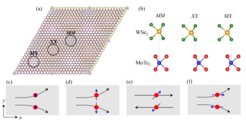Chirality-induced quantum transport in heterostructures
Chirality is a property of asymmetry with respect to the mirror image, which is a very important concept in the wide science area. The Nobel Prize in Chemistry 2021 was awarded to Benjamin List and David W.C. MacMillan "for the development of asymmetric organocatalysis." In the field of inorganic chemistry, organic chemistry, physical chemistry, and even biochemistry, the identification of the chirality in nanoparticles or molecules is crucial for asymmetric production and selection. Recently in the study of chiral crystals, a direct correlation was observed between physical properties such as the Chern number of a quasiparticle and the chiral structures of solids. In previous work, we proposed a method to detect multifold fermions of opposite chirality using second-order optical transports [1,2]. A change in structural chirality is indicated by a corresponding change in the sign of the second-order charge current dominated by chiral fermions. We studied the interplay between charge (spin) transport and spin chirality in chiral antiferromagnet [3] and the spin-polarized current in chiral crystals [4] at the linear response region. These properties can be exploited to study the relationship between chiralities in reciprocal and real spaces utilizing bulk transport.

Here in semiconductor heterostructures, we propose to study the chirality-induced spin transport where mirror symmetry is broken by intertwined moiré bands through interlayer coupling [5]. In such systems, local mirror symmetry breaking leads to a spin or orbital polarization in the flowing charge current in the chiral chains as shown in Fig. 1. The spin-polarized current can be detected from a spin-polarized probe using the chiral magnetoresistance effect, analogous to the high magnetoresistance observed in ferromagnetic structures. We will further study the chirality-induced superconducting diode effect.
This project will involve research activities both at the TUD, MPI-CPFS in Dresden, and the University of Tennessee at Knoxville. Ph.D. students will be registered at TU Dresden, and may visit the University of Tennessee in the USA during the program period.












